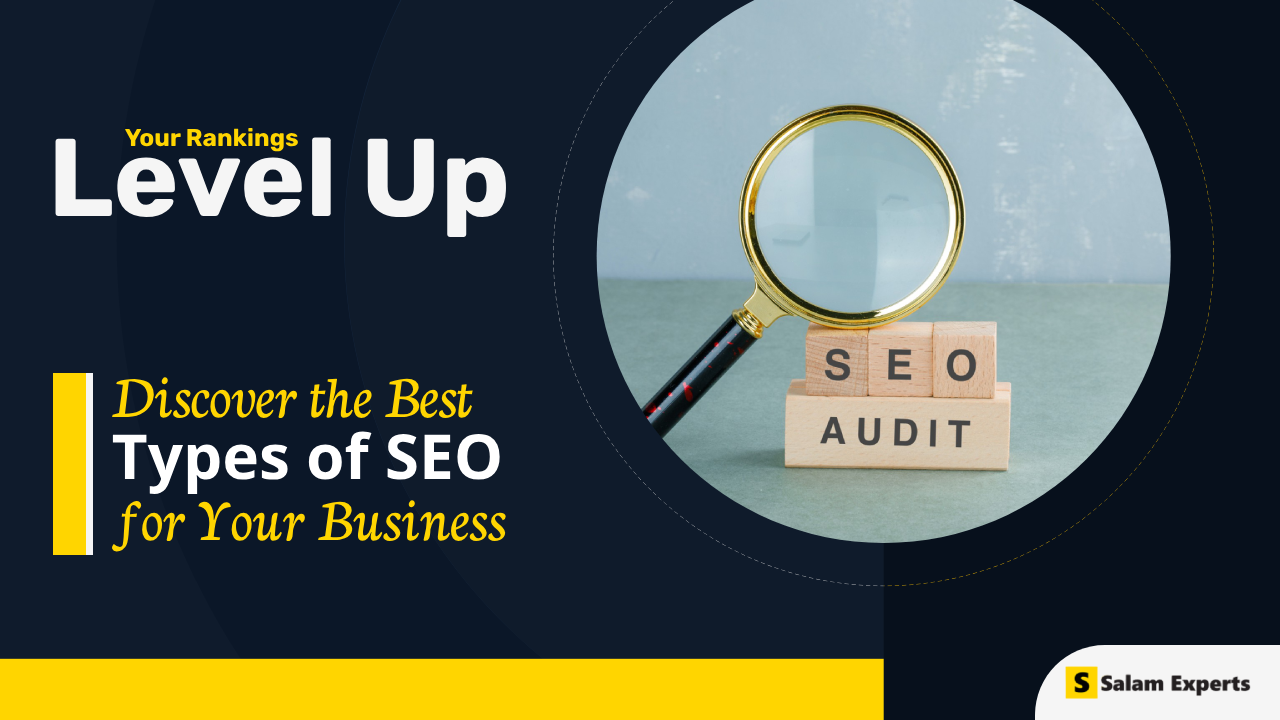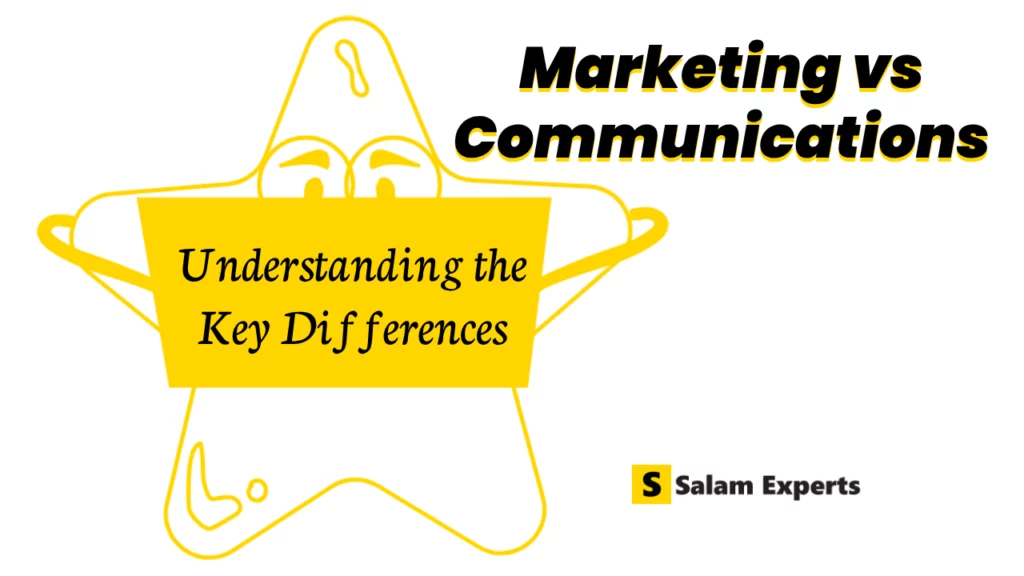Discover the Best Types of SEO for Your Business

Search engine optimization (SEO) is the process of optimizing your website to improve its ranking in search engine results pages (SERPs). The higher your website ranks, the more likely people are to click on it and visit your site. There are many different types of SEO, each with its focus and strategies. In this blog post, we will discuss the most important types of SEO that you need to know in 2024.
Key Highlights
- The blog emphasizes that effective SEO in 2024 involves more than just technical optimizations. It highlights the importance of content quality, user experience, ethical practices, and adapting to search engine algorithm updates.
- The post explores a wide range of SEO types, catering to various business needs and industries. From local SEO for brick-and-mortar stores to niche SEO for specific target audiences, it emphasizes the need for a customized approach.
- The blog delves into emerging trends like voice search, AI automation, and entity-based SEO, urging businesses to consider how these developments might impact their future strategies.
- The blog stresses the importance of ethical SEO practices like avoiding black hat tactics and prioritizing user experience. This ensures long-term success and aligns with search engine guidelines.
On-Page SEO
On-page SEO refers to the optimization of the elements on your website that you have direct control over. These elements that should be optimized in on-page SEO include your website’s content, title tags & meta descriptions, header tags, and image alt text. By optimizing these elements, you can help search engines understand what your website is about and how it is relevant to user search queries.
Off-Page SEO
Off-page SEO refers to the optimization of the elements on your website that you do not have direct control over. This includes things like backlinks, brand mentions, and social media engagement. By building backlinks to your website, you can improve its authority and trust in the eyes of search engines. Brand mentions and social media engagement can also help to improve your website’s visibility and ranking.
Technical SEO
Technical SEO refers to the optimization of the technical aspects of your website that can affect its ranking in search results. This includes things like your website’s loading speed, mobile-friendliness, and crawl ability. By optimizing these elements, you can make it easier for search engines to crawl and index your website, which can lead to better rankings.
Local SEO
Local SEO is a type of SEO that focuses on improving your website’s ranking in local search results. This is important for businesses that have a physical location and want to attract customers in their local area. By optimizing your website for local search, you can increase your chances of appearing in search results for queries like “best restaurant near me” or “dentist in [your city].”
Mobile SEO
Mobile SEO is a type of SEO that focuses on optimizing your website for mobile devices. This is increasingly important, as more and more people are using their smartphones and tablets to search the web. By improving mobile responsiveness ensuring your site adapts smoothly to different screen sizes you can make sure that it is easy to use and navigate on these devices. This not only enhances user experience but can also positively impact your search engine rankings.
E-Commerce SEO
E-commerce SEO is a type of SEO that focuses on optimizing your website for online shopping. This is important for businesses that sell products or services online. By optimizing your website for e-commerce SEO, you can improve your chances of appearing in search results for product-related queries and increase your sales.
Additional Types of SEO
Video SEO
Optimizing video content on your website and other platforms like YouTube to rank higher in search results. This includes using relevant keywords in titles, descriptions, and tags, as well as creating high-quality, engaging videos.
Image SEO
Optimizing images on your website for search engines by using descriptive filenames, alt text, and captions. This helps search engines understand the content of your images and rank them accordingly. For advanced strategies, check out how AI is transforming image SEO in WordPress.
News SEO
Optimizing your website for real-time and ongoing news content. This involves publishing fresh, relevant articles frequently, using structured data markup, and submitting your content to news aggregators.
App Store SEO (ASO)
Optimizing your app listing in app stores like Google Play and the App Store. This involves using relevant keywords in your app title, description, and keywords, as well as encouraging positive reviews and ratings.
International SEO
Optimizing your website for different languages and regions is crucial for reaching a global audience. This involves translating your content, using hreflang tags to specify the target language of each page, and building backlinks from websites in your target region. To succeed globally, you must follow international SEO best practices that ensure your content is relevant, accessible, and properly indexed in each target market.
Multi-Channel SEO
Optimizing your website and other digital channels like social media and email marketing to work together seamlessly. This ensures consistent messaging and branding across all touchpoints with your audience.
Voice Search SEO
Optimizing your website for voice search queries. This involves using natural language keywords and long-tail phrases, as well as optimizing your website for mobile devices, as this is the primary tool for voice search.
Knowledge Graph SEO
Optimizing your website to appear in Google’s Knowledge Graph, which provides users with quick answers to their search queries. This involves creating high-quality content that is relevant to existing knowledge graph entities.
Industry-Specific SEO
Tailoring your SEO strategy to the specific needs and challenges of your industry. This may involve using industry-specific keywords, participating in industry forums and events, and building backlinks from industry-relevant websites.
Content Marketing SEO
Creating high-quality, informative content that is relevant to your target audience and optimized for search engines. This can include blog posts, articles, ebooks, infographics, and videos.
Technical SEO for Beginners
Focusing on the essential technical aspects of SEO that are important for all websites, such as website speed, mobile-friendliness, and structured data. This is a good starting point for anyone new to SEO.
Sustainable SEO
Building a long-term SEO strategy that focuses on creating high-quality content, building relationships with other websites, and providing value to your target audience. This approach is more likely to lead to long-term success than black hat SEO tactics that try to game the search engine algorithms.
Public Relations SEO
Using public relations strategies to generate backlinks to your website and improve your brand awareness. This can involve pitching stories to journalists, participating in industry events, and creating newsworthy content.
Influencer Marketing SEO
Partnering with influencers in your industry to promote your website and content. This can be a great way to reach a wider audience and build trust with potential customers.
YouTube SEO
Optimizing your YouTube videos to rank higher in search results and get more views. This involves using relevant keywords in your titles, descriptions, and tags, as well as creating high-quality, engaging videos.
Local SEO for Service Businesses
Optimizing your website and online presence to attract local customers. This involves claiming your Google My Business listing, optimizing your website for local keywords, and building backlinks from local websites.
E-commerce SEO for Large Retailers
Optimizing your online store to rank higher in search results and attract more customers. This involves using relevant keywords throughout your product pages, optimizing your website for mobile devices, and running paid search ads.
Niche SEO
Targeting a specific, well-defined audience with your content and optimization efforts. This allows for laser-focused content and attracts highly relevant traffic.
Geofencing SEO
Leveraging location-based services to target users within a specific geographic area. This is ideal for brick-and-mortar businesses or campaigns with a regional focus.
Semantic SEO
Optimizing content based on meaning and intent, rather than just keywords. This aligns with how search engines are evolving to understand user queries better.
Question-based SEO
Creating content that directly answers user questions in search results. This can improve click-through rates and engagement.
Featured Snippet SEO
Optimizing content to appear in the coveted “featured snippet” at the top of search results, drawing immediate user attention.
Structured Data SEO
Using structured data markup to provide search engines with richer information about your content, potentially enhancing search results.
Omnichannel SEO
Aligning your SEO efforts across various online and offline channels like social media, email marketing, and physical stores for a unified experience.
Remember, the most effective SEO strategy is not just about ticking boxes for each type. It’s about understanding your target audience, their needs, and how search engines work, and then creating a customized approach that blends multiple relevant types for optimal results.
Enterprise SEO
Large-scale businesses often require a specialized approach to SEO. Enterprise SEO involves managing the complexities of extensive websites, multiple departments, and diverse target audiences. It includes strategies like content governance, scalable link-building tactics, and collaboration between various teams to ensure a cohesive and effective SEO strategy.
Reputation Management SEO
Online reputation is critical for businesses, and Reputation Management SEO focuses on shaping and maintaining a positive online image. This involves monitoring online reviews, addressing negative feedback, and promoting positive content. A strong online reputation not only influences user perception but can also impact search engine rankings.
Vertical SEO
Vertical SEO is industry-specific optimization tailored to meet the unique needs of a particular sector. Different industries may have distinct search patterns, user behaviors, and competition levels. Vertical SEO involves understanding the nuances of a specific industry and crafting a strategy that aligns with its requirements.
Algorithmic SEO
Search engines continually update their algorithms, impacting how websites are ranked. Algorithmic SEO involves staying abreast of these changes and adjusting strategies accordingly. SEO professionals need to adapt to algorithm updates, such as Google’s core algorithm updates, to ensure that a website maintains or improves its ranking positions.
Black Hat SEO
- Definition: Black hat SEO refers to practices that deliberately exploit search engine algorithms to gain an unfair ranking advantage. These tactics often violate search engine guidelines and can result in penalties or even website deindexing.
- Common Techniques: Keyword stuffing, hidden text, link buying, link schemes, cloaking, doorway pages, etc.
- Risks: Penalties from search engines, damaged website reputation, and potential legal repercussions.
White Hat SEO
- Definition: White hat SEO refers to ethical and sustainable practices that adhere to search engine guidelines and focus on providing a positive user experience.
- Common Techniques: Keyword research, high-quality content creation, on-page optimization, technical SEO, link building from reputable sources, etc.
- Benefits: Improved organic search ranking, increased website traffic, enhanced brand reputation, and long-term success.
Gray Hat SEO
Gray Hat SEO falls between White Hat SEO (ethical practices) and Black Hat SEO (unethical practices). It involves tactics that may be considered borderline ethical by search engines. While not strictly against the rules, Gray Hat SEO practices can carry risks, and websites using them may face penalties. Examples include clickbait content and moderate link schemes.
Imagine a spectrum where white hat SEO, with its ethical practices, rests at one end, and black hat SEO, with its risky shortcuts, sits at the other. In the nebulous middle ground lies gray hat SEO, employing tactics that blur the lines between right and wrong.
What Exactly is it?
Gray hat SEO involves techniques that exploit loopholes or push the boundaries of search engine guidelines. While not explicitly violating the rules, they raise ethical concerns and carry some degree of risk.
Examples of Gray Hat Tactics:
- Guest Blogging with Low-Quality Websites: Building backlinks through guest posts on sites with questionable relevance or authority.
- Keyword Stuffing in Meta Descriptions: Overloading meta descriptions with relevant keywords to manipulate search results, despite harming readability.
- Cloaking: Serving different content to search engines and users, potentially tricking search engines into ranking irrelevant content.
- Automated Link Building: Using software or services to acquire backlinks in bulk, often from low-quality sources.
Why Do People Use It?
The allure of gray-hat SEO lies in its potential for faster results compared to white-hat tactics. It can offer quicker ranking improvements, especially for competitive keywords.
However, be Warned
- Risks are Real:
Search engines constantly update their algorithms, and tactics that work today might be penalized tomorrow. Getting caught can lead to website deindexing or ranking drops. - Ethical Considerations:
Some gray hat tactics border on deception, manipulating search engines and potentially harming the user experience. - Sustainability Concerns:
Short-term gains might not translate into long-term success. Building a website on shaky foundations can be hard to sustain.
Industry-Specific Variations
Some industries have unique SEO needs and nuances due to regulations, competitor landscapes, and user behavior. For example, healthcare SEO involves adhering to specific compliance regulations, while legal SEO often requires optimizing for complex search queries and building domain authority.
Emerging Technologies
As technology evolves, new SEO frontiers emerge. For instance, with the rise of voice search, optimizing content for natural language queries becomes crucial. Similarly, augmented reality (AR) experiences might require specific SEO strategies in the future.
Personalization and User Experience
Search engines are increasingly focusing on personalizing results based on user intent and past behavior. Optimizing for a well-rounded user experience, including website responsiveness, content relevance, and clear navigation, becomes paramount.
Ethical Considerations
As SEO continues to evolve, ethical considerations remain crucial. Balancing effective strategy with responsible practices ensures long-term success and aligns with the core principles of providing valuable information to users.
Micro-Moments SEO
This focuses on targeting specific user needs at precise moments in their search journey. Imagine someone searching for “best nearby pizza delivery” while feeling hungry – optimizing your pizzeria’s website for such micro-moments can be powerful.
Entity-Based SEO
Aligning your website with authoritative entities related to your niche helps search engines understand your content better. Think of building connections with industry organizations, experts, or well-known brands in your field.
Accessibility SEO
Making your website accessible to users with disabilities not only aligns with ethical principles but can also indirectly benefit SEO by improving website usability and user experience.
Sustainable SEO beyond White Hat
Explore strategies that go beyond basic white hat practices while remaining within ethical boundaries. This might involve repurposing content effectively, leveraging internal linking strategically, or implementing resource optimization techniques.
Data-driven SEO with AI Automation
Leverage artificial intelligence (AI) tools to analyze vast amounts of search data and automate repetitive tasks. This can help identify optimization opportunities, track keyword performance, and personalize content for better user engagement.
Experimentation and Growth Hacking for SEO
Don’t be afraid to experiment with new tactics and growth hacking strategies within ethical boundaries. A/B tests different headlines, meta descriptions, or website layouts to see what resonates best with your audience and adapt your approach based on the results.
Conclusion:
SEO is a complex and ever-evolving field. However, by understanding the different types of SEO and implementing the right strategies, you can improve your website’s ranking in search results and attract more visitors.
Author
-

We are a digital marketing agency with over 17 years of experience and a proven track record of helping businesses succeed. Our expertise spans businesses of all sizes, enabling them to grow their online presence and connect with new customers effectively. In addition to offering services like consulting, SEO, social media marketing, web design, and web development, we pride ourselves on conducting thorough research on top companies and various industries. We compile this research into actionable insights and share it with our readers, providing valuable information in one convenient place rather than requiring them to visit multiple websites. As a team of passionate and experienced digital marketers, we are committed to helping businesses thrive and empowering our readers with knowledge and strategies for success.
View all posts




